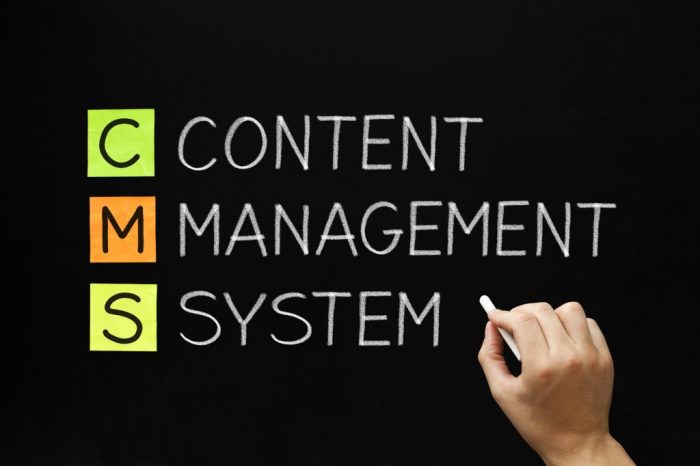Using Content Management Tools at the forefront, get ready to dive into a world where organization meets creativity, where businesses thrive with the power of digital tools at their fingertips. From defining these tools to exploring their impact, this journey promises to be enlightening and exciting.
Introduction to Content Management Tools
Content Management Tools are software applications designed to help businesses create, manage, and publish digital content on websites or other platforms. These tools streamline the process of content creation, editing, and organization, making it easier for businesses to maintain a consistent online presence.
Using Content Management Tools is crucial for businesses to effectively manage their online content, ensuring that it is up-to-date, relevant, and engaging for their target audience. These tools enable businesses to easily update their websites, blogs, or social media channels without the need for technical expertise, allowing them to focus on creating high-quality content that resonates with their customers.
Some popular Content Management Tools in the market include WordPress, Joomla, Drupal, and Squarespace. These platforms offer a range of features and customization options to suit different business needs, making it easier for organizations to create and publish content efficiently.
Benefits of Content Management Tools
- Streamline content creation and publishing processes
- Improve website performance and user experience
- Enhance and digital marketing efforts
- Facilitate collaboration among team members
- Provide analytics and insights for better decision-making
Features and Functionality of Content Management Tools

Content Management Tools are essential for businesses and individuals looking to efficiently manage their content online. These tools offer a wide range of features that make the process of organizing and managing content much easier.
One key feature of Content Management Tools is the ability to create, edit, and publish content seamlessly. Users can easily update their websites or online platforms without the need for complex coding knowledge. This feature is especially useful for those who are not tech-savvy but still want to maintain a professional online presence.
Another important functionality of Content Management Tools is the ability to categorize and tag content. This helps in organizing content effectively, making it easier for users to search and access specific information quickly. By using tags and categories, users can streamline the content management process and ensure that their audience can find what they are looking for easily.
Furthermore, Content Management Tools often come with collaboration features that allow multiple users to work on the same content simultaneously. This is particularly beneficial for teams working on projects together, as it promotes better communication and efficiency in content creation.
Comparison of Different Content Management Tools, Using Content Management Tools
When it comes to choosing a Content Management Tool, it’s important to consider the specific functionalities each tool offers. Here are some popular Content Management Tools and how they compare based on their key features:
- WordPress: Known for its user-friendly interface and extensive plugin library, WordPress is a great choice for beginners and experienced users alike. It offers a wide range of customization options and themes to create unique websites.
- Drupal: Drupal is a powerful Content Management System that is highly customizable and scalable. It is favored by large organizations and businesses due to its robust security features and advanced functionality.
- Joomla: Joomla is a flexible CMS that strikes a balance between ease of use and advanced features. It is suitable for creating various types of websites, from simple blogs to complex e-commerce platforms.
Benefits of Using Content Management Tools

Content management tools offer a wide array of benefits for businesses looking to streamline their content creation process and enhance productivity. By utilizing these tools, companies can effectively manage their digital content, collaborate more efficiently, and improve their overall content strategy.
Improved Workflow Efficiency
- Content management tools provide a centralized platform for organizing and storing content, allowing team members to access and collaborate on projects in real-time.
- Automation features streamline repetitive tasks, such as scheduling content publication and updating metadata, saving valuable time and reducing manual errors.
- Version control capabilities ensure that team members are working on the most up-to-date content, minimizing confusion and streamlining the review process.
Enhanced Productivity
- Content management tools enable teams to work more efficiently by providing customizable workflows and task assignments, ensuring that projects are completed on time and within budget.
- Integration with other tools and platforms, such as social media scheduling tools and analytics software, allows for seamless content distribution and performance tracking.
- Content analytics features provide valuable insights into content performance, helping businesses optimize their strategies and drive better results.
Success Stories
“Company X saw a 30% increase in website traffic after implementing a content management tool to streamline their content creation process and improve collaboration among team members.”
“By utilizing a content management tool, Company Y was able to reduce their content production time by 50%, resulting in higher efficiency and cost savings.”
Best Practices for Utilizing Content Management Tools: Using Content Management Tools
When it comes to utilizing Content Management Tools effectively, it is essential to design a strategy that aligns with your content creation goals. By organizing content creation workflows and optimizing content for , you can maximize the benefits of these tools.
Design a Strategy for Effective Use
Creating a strategy for utilizing Content Management Tools involves setting clear objectives and defining the roles and responsibilities of team members involved in the content creation process. By establishing a workflow that Artikels the steps from ideation to publication, you can ensure a smooth and efficient content creation process.
- Set specific goals for your content creation efforts, such as increasing website traffic, generating leads, or improving brand visibility.
- Identify your target audience and tailor your content to meet their needs and preferences.
- Collaborate with team members to brainstorm ideas, create content calendars, and track progress towards your goals.
- Regularly review and analyze the performance of your content to identify areas for improvement and optimization.
Organize Content Creation Workflows
Organizing content creation workflows using Content Management Tools can help streamline the content production process and ensure consistency in quality and messaging. By creating templates, establishing approval workflows, and utilizing collaboration features, you can enhance productivity and efficiency.
- Develop content templates for different types of content, such as blog posts, social media updates, and email campaigns, to maintain a consistent style and format.
- Implement approval workflows to ensure that content is reviewed and approved by relevant stakeholders before publication.
- Utilize collaboration features to facilitate communication and feedback among team members, allowing for seamless collaboration on content creation projects.
- Track the progress of content creation tasks and deadlines to ensure that projects stay on schedule and meet established goals.
Optimize Content for
Optimizing content for using Content Management Tools is crucial for improving search engine rankings and driving organic traffic to your website. By incorporating relevant s, optimizing meta tags, and monitoring performance metrics, you can enhance the visibility and reach of your content.
research is essential for identifying relevant search terms that your target audience is using to find information online.
| Optimization Technique | Description |
|---|---|
| Include target s in the title, headings, and body of your content. | Optimizing content for specific s can improve its relevance and visibility in search results. |
| Create unique meta tags, including meta titles and meta descriptions, to provide search engines with information about your content. | Meta tags play a crucial role in determining how your content appears in search results and can impact click-through rates. |
| Monitor performance metrics, such as organic traffic, rankings, and backlink profiles, to evaluate the effectiveness of your efforts. | Regularly analyzing performance data can help you identify areas for improvement and refine your strategy over time. |






